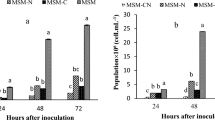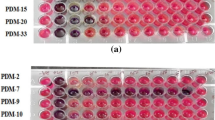Abstract
Xenobiotic thiencarbazone-methyl is a herbicide applied on various grasses and weeds. This triazolinone pesticide may be present in soil and water after application posing deleterious effects on environment and human health. The degradation of thiencarbazone-methyl was scrutinized by the pure bacterial strains including Streptococcus pneumoniae (SP), Escherichia coli (EC) and Streptococcus pyogenes (SPy). Individual bacterial suspension was prepared with herbicide solution and evaluated for a duration of 28 days. Time-dependent sampling was performed to investigate thiencarbazone-methyl degradation after specific days interval. Biotransformed samples were extracted and analyzed by UV–Vis spectrophotometer and GC–MS. Biodegradation percentage achieved by SP, Spy and EC, after 28 days, was 31, 40 and 65, respectively. E. coli (R2= 0.91) displayed greatest potential among all the strains to degrade the herbicide. Significant residues formed included methyl 4-isocyanatosulfonyl-5-methylthiophene-3-carboxylate, 4-methanesulfonyl-benzenesulfonic acid amide and methyl 3-sulfamoylthiophene-2carboxylate. Current research elucidated the effectiveness of using bacterial strains for the bioremediation of pesticides in environment.




Similar content being viewed by others
References
Ahmad KS (2019) Carbendazole lithospheric adsorption, Saccharum officinarum-based remediation and microbial degradation in heterogeneously composed soils. Environ Earth Sci 78(1):31
Ahmad KS (2020a) Environmental contaminant 2-chloro-N-(2, 6-diethylphenyl)-N-(methoxymethyl) acetamide remediation via Xanthomonas axonopodis and Aspergillus niger. Environ Res 182:109117
Ahmad KS (2020b) Remedial potential of bacterial and fungal strains (Bacillus subtilis, Aspergillus niger, Aspergillus flavus and Penicilliumchrysogenum) against organochlorine insecticide Endosulfan. Folia Microbiol 65:801
Ahmad KS, Gul P (2020) Fungicide isopyrazam degradative response toward extrinsically added fungal and bacterial strains. J Basic Microbiol 60:484–493
Carvalho FP (2017) Pesticides, environment, and food safety. Food Energy Security 6(2):48–60
El Bestawy E, Ahmed AH, Amer R, Kashmeri RA (2014) Decontamination of domestic wastewater using suspended individual and mixed bacteria in batch system. J Biorem Biodeg 5:1
European Food Safety Authority (2013) Conclusion on the peer review of the pesticide risk assessment of the active substance thiencarbazone-methyl. EFSA J 11(7):3270
Gul MM, Ahmad KS (2018) Chlorsulfuron degradation through bio-augmentation of soils by fungal strains and chemical hydrolysis. J Environ Chem Eng 6:955–963
Gul MM, Ahmad KS (2020) Assessment of methyl 2-({[(4, 6-dimethoxypyrimidin-2-yl) carbamoyl] sulfamoyl} methyl) benzoate through biotic and abiotic degradation modes. Open Chem 18(1):314–324
Leonie W, Krähmer H, Santel HJ, Claupein W, Gerhards R (2014) Thiencarbazone-methyl efficacy, absorption, translocation, and metabolism in vining weed species. Weed Sci 62(3):512–519
Naeem H, Ahmad KS, Gul MM (2020) Agrochemical 2-chloro-2′, 6′-diethyl-N-methoxymethylacetanilide tranformative and sorptive demeanor in agriculturally significant pedospheric environs. Int J Environ Anal Chem. https://doi.org/10.1080/03067319.2019.1700965
Ortiz-Hernández ML, Sanchez-Salinas E, Godínez MLC, González ED, Ursino ECP (2013) Mechanisms and strategies for pesticide biodegradation: opportunity for waste, soils and water cleaning. Rev Int Contam Amb 29:85–104
Pannacci E, Onofri A (2016) Alternatives to terbuthylazine for chemical weed control in maize. Commun Biometry Crop Sci 11:51–63
Santel HJ (2012) Thiencarbazone-methyl (TCM) and cyprosulfamide (CSA)–a new herbicide and a new safener for use in corn. Julius-Kühn-Archiv 2(434):499
Sarkar S, Seenivasan S, Premkumar R (2009) Biodegradation of propiconazole by Pseudomonas putida isolated from tea rhizosphere. Plant Soil Environ 55:196–201
Satapute P, Kaliwal B (2016) Biodegradation of the fungicide propiconazole by Pseudomonas aeruginosa PS-4 strain isolated from a paddy soil. Ann Microbiol 66:1355–1365
Stephenson DO, Bond JA (2012) Evaluation of thiencarbazone-methyl–and isoxaflutole-based herbicide programs in corn. Weed Technol 26(1):37–42
Szmigielski AM, Schoenau JJ, Johnson EN, Holm FA, Sapsford KL (2012) Determination of thiencarbazone in soil by oriental mustard root length bioassay. Weed Sci 60:468–473
Tang M, You M (2012) Isolation, identification and characterization of a novel triazophos-degrading Bacillus sp. (TAP-1). Microbiol Res 167:299–305
Wendt MJ, Wegener M, Ladewig E, Märländer B (2016) Efficacy of foramsulfuron + thiencarbazone-methyl towards different development stages of weed species in sugar beet cultivation. Sugar Indus 141:436–445
Wendt MJ, Kenter C, Ladewig E, Wegener M, Märländer B (2017a) Duration of soil activity of foramsulfuron plus thiencarbazone-methyl applied to weed species typical of sugar beet cultivation. Weed Technol 31:291–300
Wendt MJ, Kenter C, Stibbe C, Ladewig E, Märländer B (2017b) Selectivity of foramsulfuron + thiencarbazone-methyl and classic herbicides in sensitive and non-sensitive sugar beet genotypes. Weed Res 57:267–277
Wu H, Shen J, Wu R, Sun X, Li J, Han W, Wang L (2016) Biodegradation mechanism of 1H-1, 2, 4-triazole by a newly isolated strain Shinella sp. NJUST26. Scientific Rep 6:1–10
Zhang X, Hsung RP, Li H (2007) A triazole-templated ring-closing metathesis for constructing novel fused and bridged triazoles. Chem Commun 23:2420–2422
Acknowledgements
The authors acknowledge Higher Education Commission of Pakistan, the Department of Environmental Science (Lab E-21) and Fatima Jinnah Women University, Pakistan. This work was funded by Researchers Supporting Project Number (RSP-2020/165), King Saud University, Riyadh, Saudi Arabia.
Author information
Authors and Affiliations
Corresponding author
Ethics declarations
Conflict of interest
All authors declare that there is no conflict of interest.
Additional information
Editorial responsibility: Shahid Hussain.
Rights and permissions
About this article
Cite this article
Ahmad, K.S., Hafeez, N., Gul, M.M. et al. Xenobiotic thiencarbazone-methyl biotransformation investigation by bacteria Streptococcus pneumoniae, Escherichia coli and Streptococcus pyogenes. Int. J. Environ. Sci. Technol. 18, 1753–1760 (2021). https://doi.org/10.1007/s13762-020-02948-x
Received:
Revised:
Accepted:
Published:
Issue Date:
DOI: https://doi.org/10.1007/s13762-020-02948-x




